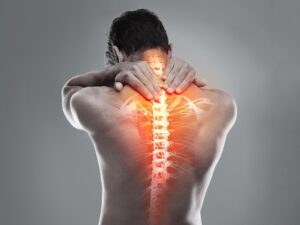Scientists Discover Potential Opioid Replacement for Back Pain
- Biotechnology
- No Comment
- 229

The study indicates that nanocarriers loaded with DNA may serve as alternatives to opioids.
Recent research demonstrates that gene therapy delivered by nanocarriers can effectively repair spinal discs and reduce back pain in mice, offering a promising alternative to traditional pain management methods and potentially improving surgical outcomes.
Disc-related back pain may one day meet its therapeutic match: gene therapy delivered by naturally derived nanocarriers that, a new study shows, repairs damaged discs in the spine and lowers pain symptoms in mice.
Scientists engineered nanocarriers using mouse connective-tissue cells called fibroblasts as a model of skin cells and loaded them with genetic material for a protein key to tissue development. The team injected a solution containing the carriers into damaged discs in mice at the same time the back injury occurred.
Assessing outcomes over 12 weeks, researchers found through imaging, tissue analysis, and mechanical and behavioral tests that the gene therapy restored structural integrity and function to degenerated discs and reduced signs of back pain in the animals.
“We have this unique strategy that’s able to both regenerate tissue and inhibit some symptoms of pain,” said co-senior author Devina Purmessur Walter, associate professor of biomedical engineering at Ohio State University.
Though there is more to learn, the findings suggest gene therapy could offer an effective and long-lasting alternative to opioids for the management of debilitating back pain.
Enhancing Surgical Outcomes with Gene Therapy
“This can be used at the same time as surgery to actually boost healing of the disc itself,” said co-senior author Natalia Higuita-Castro, associate professor of biomedical engineering and neurological surgery at Ohio State. “Your own cells are actually doing the work and going back to a healthy state.”
The study was published online recently in the journal Biomaterials.
An estimated 40% of low-back pain cases are attributed to degeneration of the cushiony intervertebral discs that absorb shocks and provide flexibility to the spine, previous research suggests. And while trimming away bulging tissue from a herniated disc during surgery typically reduces pain, it does not repair the disc itself – which continues to degenerate with the passage of time.
“Once you take a piece away, the tissue decompresses like a flat tire,” Purmessur Walter said. “The disease process continues, and impacts the other discs on either side because you’re losing that pressure that is critical for spinal function. Clinicians don’t have a good way of addressing that.”
This new study builds upon previous work in Higuita-Castro’s lab, which reported a year ago that nanocarriers called extracellular vesicles loaded with anti-inflammatory cargo curbed tissue injury in damaged mouse lungs. The engineered carriers are replicas of the natural extracellular vesicles that circulate in humans’ bloodstream and biological fluids, carrying messages between cells.
Development of Extracellular Vesicle Therapies
To create the vesicles, scientists apply an electrical charge to a donor cell to transiently open holes in its membrane, and deliver externally obtained DNA inside that converts to a specific protein, as well as molecules that prompt the manufacture of even more of a functional protein.
In this study, the cargo consisted of material to produce a “pioneer” transcription factor protein called FOXF1, which is important in the development and growth of tissues.
“Our concept is recapitulating development: FOXF1 is expressed during development and in healthy tissue, but it decreases with age,” Purmessur Walter said. “We’re basically trying to trick the cells and give them a boost back to their developmental state when they’re growing and at their healthiest.”
In experiments, mice with injured discs treated with FOXF1 nanocarriers were compared to injured mice given saline or mock nanocarriers and uninjured mice.
Compared to controls, the discs in mice receiving gene therapy showed a host of improvements: The tissue plumped back up and became more stable through the production of a protein that holds water and other matrix proteins, all helping promote range of motion, load bearing and flexibility in the spine. Behavioral tests showed the therapy decreased symptoms of pain in mice, though these responses differed by sex – males and females showed varying levels of susceptibility to pain based on the types of movement being assessed.
The findings speak to the value of using universal adult donor cells to create these extracellular vesicle therapies, the researchers said, because they don’t carry the risk of generating an immune response. The gene therapy also, ideally, would function as a one-time treatment – a therapeutic gift that keeps on giving.
“The idea of cell reprogramming is that you express this transcription factor and the cell is then going to convert to this healthier state and stays committed to that healthier phenotype – and that conversion is not normally transient,” Higuita-Castro said. “So in theory, you would not expect to have to re-dose significantly.”
There are more experiments t o come, testing the effects of other transcription factors that contribute to intervertebral disc development. And because this first study used young adult mice, the team also plans to test the therapy’s effects in older animals that model age-related degeneration and, eventually, in clinical trials for larger animals known to develop back problems.
o come, testing the effects of other transcription factors that contribute to intervertebral disc development. And because this first study used young adult mice, the team also plans to test the therapy’s effects in older animals that model age-related degeneration and, eventually, in clinical trials for larger animals known to develop back problems.





